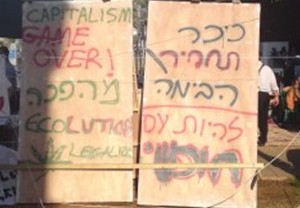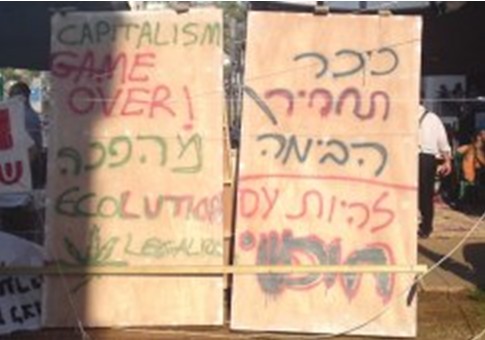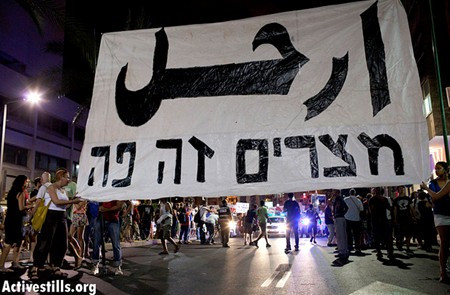
“The Corner of Al-Tahrir Square and Rothschild Avenue” – is the writing on a huge banner that is hung in Rothschild Avenue in Tel-Aviv, in the central protest encampment. The protest encampment, which started on July 14th, and gave rise to what is sometimes known as the “July 14th Movement” (J14), ushered a summer of demonstrations and mass mobilization, never before seen in Israel on such a scale.
Indeed, revolutionary spirit that engulfed the Middle East, in what became known as The Arab Spring, has finally reached Israel, albeit in a very different form and with a different content. What were the forces that gave birth to this broad protest movement, which was sweeping the country in a wave of social unrest?
The Neo-Liberal Setup
While Israel’s government boasts of the country’s vast economic growth in recent years, which even surpassed that of OECD countries[1], this growth was also accompanied in growth of poverty and income gaps. The majority of Israelis continue to suffer a decrease in their standard of living, as the cost of living rises, yet their salaries remain fixed.
According to a report by the National Insurance Institute of Israel, “the dimensions of poverty in Israel are twice as high compared to the OECD average, and 1.5 times as high with regard to income gaps… the severity of the poverty increased and steeply reached a peak”[2]. One third of Israel’s children live below the poverty line, and among the Arab-Palestinian citizens of Israel (who comprise about 20% of the country’s population) – two thirds of the children live below the poverty line[3].
The growing poverty rates in Israel are not a new phenomena. Since the early 2000s, and especially since 2003, when Benyamin Netanyahu was appointed as Minister of Finance in the cabinet of Ariel Sharon, harsh neo-liberal measures were implemented: massive privatization of publicly owned companies; cuts in children benefits, disability allowances and old age allowances; lowering of corporate taxes and cutting public spending.
Adding to this, the cost of living is rising, and this affects practically all homes in Israel: Electricity rates just rose by 10%, and in the past few months we’ve also witnessed an increase in the price of public transportation, gasoline, water and basic food necessities. The government’s unwillingness to provide a solution to the price increases (either in the form of a cost-of-living allowance, or through intervention in the pricing policy) angered many working people and families.
The government’s neo-liberal economic policies – coupled with rising prices and stagnant salaries – meant not only that people just above the poverty line had quickly sunk below it, but also that more and more people from what is considered ‘the middle class’ found themselves struggling to make ends meet. This is especially true for young people, many of which are employed in precarious jobs, without job security and without long term social benefits.
People who otherwise wouldn’t regard themselves as being part of the poorer echelons of society – i.e, people with university degrees, living in the major urban centers in Israel, who come from a family with a secured jobs, etc. – discovered that contrary to what the government says, their economic future is entirely insecure. “The economy is heading the right way”, so says the government; “But then why is it so difficult to make a decent living?”, people ask.
Nowhere was the proletarization of the ‘middle strata’ in Israel more evident, than in the field of housing. Rental prices in Israel rose by 34% in the past six years, with a 49% increase in Tel Aviv[4]. People would pay up to half of their salaries for rent, and the dream of owning a house is but a distant dream to the majority of Israelis.
Thus, neo-liberalism laid the ground for a broad strata of Israeli society – which is otherwise politically passive and dormant – to be ready to take to the streets. All that what was needed was a spark.
‘Tentifada’ – The Tents Protest Movement is Born
On July 14th, in a move which received wide media coverage, a few hundred young people, organized through a Facebook call, laid tents and sleeping bags in Rothschild Avenue, in the very middle of Tel Aviv. Their encampment was in protest of the insanely high rents in Israel, especially in Tel Aviv, and their aim to express the disgruntlement of the ‘middle class’.
While the organizers, who were inspired by the tent city in Puerta de Sol in Madrid, expected the protest to last for just a few days, more and more tents were set up and the protest grew larger. The first march was called for July 23rd, and it attracted a crowd of 30,000, which is considered a big demonstration in Israeli terms.
The National Union of Students joined the protest movement, and dozens of encampments sprang up throughout the country. This was no longer merely a “Tel-Aviv phenomena”, but a cause that struck a chord with people across the country.
In a mere few days since it first began, the movement grew not only in width, but also in depth. The question of housing became but one issue that people were protesting about: young parents organized demonstrations against the high cost of kindergartens and day-care centers; teachers and educators were protesting the dire situation of the underfunded public education system; hospital doctors – striking since April – joined the protest movement, demanding higher wages and more government spending on the public health system.
The very fragmented Israeli society, which lacks a trade unionist tradition of solidarity and social struggles, suddenly witnessed a vibrant and dynamic social protest movement, led by young people, which was able to bring together people from different walks of life.
On July 30th a 150,000 strong demonstration was held in Tel Aviv, with big rallies held also in Jerusalem and Haifa. A week afterwards – 300,000 marched in Tel Aviv, in one of the biggest demonstration ever in Israel. On September 3rd the “March of the Million” was held, with half a million protesters marching in the streets – 300,000 in Tel Aviv, and almost 200,000 others in 17 cities all over Israel. This amounts to around 6% of Israel’s population. For comparison, it is as if 5 million were demonstrating at once in Germany.
Shortly after the protests began, the leadership of the protest movement was under criticism for not placing concrete enough demands on the agenda, but rather preferring to speak abstractly and vaguely about social justice. Soon after, various demands have been made for increasing government spending, especially in the area of public housing, but also in providing free education for all.
Did the Arab Spring turn into an Israeli Summer?
The protest movement in Israel is unfolding in an international atmosphere of social unrest: In February, Portugal saw the biggest demonstration since the 1974 Carnation Revolution; In May, Spanish young people launched a protest movement against the government’s policies; In June, Greek students also took to the streets. The J14 movement in Israel most be understood against this backdrop.
However, Israel is not located in Europe, but in the Middle East. It would be incorrect to ignore the implications that the regional developments – in Tunisia, Egypt, the Arab peninsula and elsewhere – had and still have on the development of the social protest in Israel.
For years, the Israeli establishment encouraged a mentality of “villa in the jungle” among the Jewish population in Israel, refusing to recognize Israel’s location within the Arab East, and promoting a feeling of distrust and fear towards Arab culture, and towards any progressive political developments within the Arab world. Therefore, when the Arab peoples took to the streets in rebellion and toppled the dictators Mubarak and Ben Ali, many Israeli looked upon these developments with mixed feelings.
These mixed feelings did not prevent the mass protest movement in Israel from resonating – yet not imitating – the Arab Spring. The rallying cry of the J14 Movement, which became the chant most recognized with this Israeli Summer, is “The People Demand Social Justice” – chanted to the exact same rhythm with which the Cairo protesters in Al-Tahrir square chanted “The People Demand the Fall of the Regime”.
Some protestors even took it up a notch, chanting: “Mubarak, Assad, Netanyahu”[5]. Equating Mubarak with Netanyahu was also seen in the August 6th Tel-Aviv demonstration, were protestors unfolded a huge banner that read in Hebrew “Egypt is Here”, and in Arabic, the Egyptian slogan: “Go Away”[6] (directed towards the head of government).
Yet while we can indeed rejoice that parts of the Israeli public, for once, are embracing some of the symbolism of the Arab rebellion, we must also be critically aware of the differences between the protests in Israel and the protests elsewhere in the Middle East.
The protest movement won such a wide support among Israelis (A Channel 10 survey, in early August, showed that 85% of Israelis support the protest) mainly because, unlike its Egyptian counterpart, it did not put forward the demand to replace the government of the Likud Party. Many of the Israeli demonstrators insist that their demand is not for the overthrow of Netanyahu, but for “making him listen to us, so he would take action to fix the problems”.
Thus, Communists and Likud voters (yet no Likud politicians) found themselves marching in the same demonstrations, chanting similar slogans, yet having an opposing perspective on what should happen next.
The leadership of the movement contributed to this ambiguity regarding the aim of the protests, by not clarifying its position on Netanyahu and his government. They’ve insisted: “This is not a protest of the Left, nor of the Right, but of all the people”. While this strategy certainly helped the general public to view more positively the protest movement, the lack of clarity also means that the mass mobilizations had not yet made any concrete gains in the political sphere – not replacing the government or forcing new elections, and not even winning a more socially just budget for the year 2012.
Also, the protest movement have failed to address the unique social problems facing the Arab-Palestinian minority in Israel, especially in the field of housing: Arab towns and villages face an acute housing crisis, manifested by lack of building permits and confiscation of lands; Regional and local outline plans for the Arab towns and villages are inadequate, without allocation of proper areas for development of housing; Building permits are not given on an equal basis; A brutal policy of house demolitions is implemented, especially in the so-called “Unrecognized villages” of Bedouin tribes in the south of Israel.
In light of this adoption of an “apolitical” rhetoric, the Central Committee of the Communist Party of Israel stated that there is urgent need to clarify the ideological nature of the basic struggle which is a struggle between two opposed paths: a state that is responsible for every citizen and resident, versus a state that abandons them to the forces of the market. It is also important to outline the political nature of the struggle which means that any real change in favor of the average people requires the overthrow of Netanyahu’s government[7].
Despite the ambiguous language of the leadership of the movement, considerable gains have been made not in the political sphere, but ideologically, in the consciousness of the people. The very fact that hundreds of thousands of people mobilized, and thousands of them participated actively in the democratic maintenance of the protest encampments is an achievement not to be taken lightly. In a society were political apathy runs deep, having such a great number of people – especially young people – debate, on a daily basis, the tactics and strategy of building the movement, organize neighborhood lectures on privatization, and participate in discussions about the nature of Capitalism, is something unheard of in Israel.
The Protest Movement and the Israeli-Palestinian Conflict
As the Israeli occupation of Palestinian territories goes into its 44th year, its black book of human rights violations and outright crimes thickens every day. The occupation has warped Israeli society, which was not at all a ‘healthy’ society to begin with, and made it more violent, more hateful, less tolerant and less democratic. The moral cost of the occupation on the society of the occupiers is enormous.
Less well known, yet documented and researched, is the economic cost of the ongoing occupation[8]. With a huge military budget that eats up government spending, advanced weapons purchase from the US, and continued expansion and maintenance of settlements in the occupied territories – all the different governments of Israel, regardless of who is the current ruling party, directed the country’s resources away from people’s needs – healthcare, housing, welfare and education.
The radical Left, most notably the Communist Party of Israel, had made the point that ending the occupation on the basis of an independent Palestinian state alongside Israel, would mean more budgets to build schools, homes, hospitals and libraries. Therefore, achieving a comprehensive, lasting and just peace, is in the interests of the Israeli public and Israeli working people.
However, as the leadership of the protest movement aimed for the center of the mainstream, the demands to make this connection, between ending the occupation and achieving social justice, remained mostly on the fringe of the movement.
True, some speakers in mass demonstrations organized by the J14 Movement had pressed this issue forward. Mostly notably, Dr. Zuheir Tibi (in a demonstration of 20,000 in Tel-Aviv) and Raja Zaatry (in a demonstration of 35,000 in Haifa). The message of these two speakers, both of which are members of the national leadership of HADASH[9], was well accepted by the crowds. Yet the movement as a movement, vis-à-vis its public demands from the government, had not touched upon the question of the Israeli occupation.
That is not to say that this question escaped it altogether: After a month of Israeli air raids on Gaza strip, a terror attack claimed the lives of several Israelis, on August 18th, near the southern town of Eilat. The Israeli government announced that a Gaza based organization is responsible, and launched deadly air strikes.
The J14 movement was put to the test: will it fold its banners, now that a bloody conflict captured the media’s attention? Will the atmosphere of national convergence push aside the protest for social justice?
Remarkably, it had passed the test, with protests taking place even in the days following the terror attack and Gaza raids. In a militaristic society such as Israel, where one can be vilified by some circles for not appearing ‘patriotic’ enough, to openly state that even at such times, the protest for social justice most have its place in the front, nor the rear, of the public stage, is quite a brave act.
Which Way Forward?
The social protest movement of the summer of 2011, whose tent cities captured the imagination of the country, is a watershed moment in Israel’s history. It was clear to many of the participants that they are taking part in an event which would shape Israeli politics for years to come.
It is reasonable to expect that the majority of those who participated in the movement – who helped organize encampments, took part in popular discussions, marched in never before seen mass demonstrations – will probably remain within the confines of the hegemonic world outlook.
But those who will break out of it, and draw political conclusions regarding Israeli society and the issues facing it, will no doubt help make an important qualitative contribution towards shifting the balance of forces away from unbridled Capitalism and from the ongoing criminal occupation.
The Palestinian poet, Mahmoud Darwish, once wrote that “This land has in it what justifies life”. Drawing from the overwhelming energy of the recent social protest movement, we will continue to struggle for a better life on this land, for all.
Uri Weltmann is a member of the National Secretariat of HADASH (The Democratic Front for Peace and Equality; the electoral front of the Communist Party of Israel).
Written for publication in the October issue of the German-language magazine ‘Wissenschaft und Frieden’ (Science and Peace): http://www.wissenschaft-und-frieden.de/.
[1] OECD raises Israel 2011 growth forecast to 5.4%: http://tinyurl.com/globes01; Israel Economic Growth Unexpectedly Accelerates to Fastest Pace Since 2008: http://tinyurl.com/bloomberg01
[2] Poverty and Social Gaps – Annual Report for 2009: http://tinyurl.com/6gkwxpo
[3] The Equality Index of Jewish and Arab Citizens of Israel (published by Sikkuy – The Association for the Advancement of Civic Equality in Israel): http://tinyurl.com/sikkuy-01
[4] Rental prices in Tel Aviv rose 49% in six years, says report: http://tinyurl.com/themarker01
[5] Israelis Chant: “Mubarak, Assad, Bibi Netanyahu” (video): http://tinyurl.com/realnews01
[7] From Social Protest to Political Change (Resolution of the Central Committee of the Communist Party of Israel, 13.8.2011): http://tinyurl.com/cpi130811
[8] Swirski, Shlomo. The Cost of the Occupation – The Burden of the Israeli-Palestinian Conflict (2010 Report, published by Adva Center): http://tinyurl.com/adva-01
[9] HADASH (Hebrew acronym for “Democratic Front for Peace and Equality”) is a radical Left coalition, formed in 1977, comprised of the Communist Party of Israel and other, smaller groups. In the recent Knesset (parliament) elections in 2009, it won 3.32% of the votes, which amounts to four members of Knesset out of 120.




